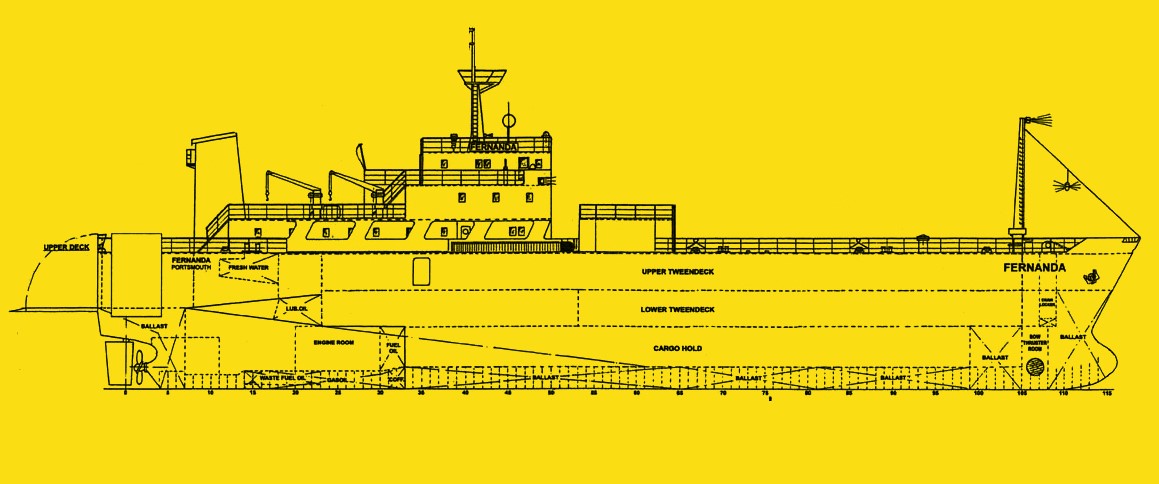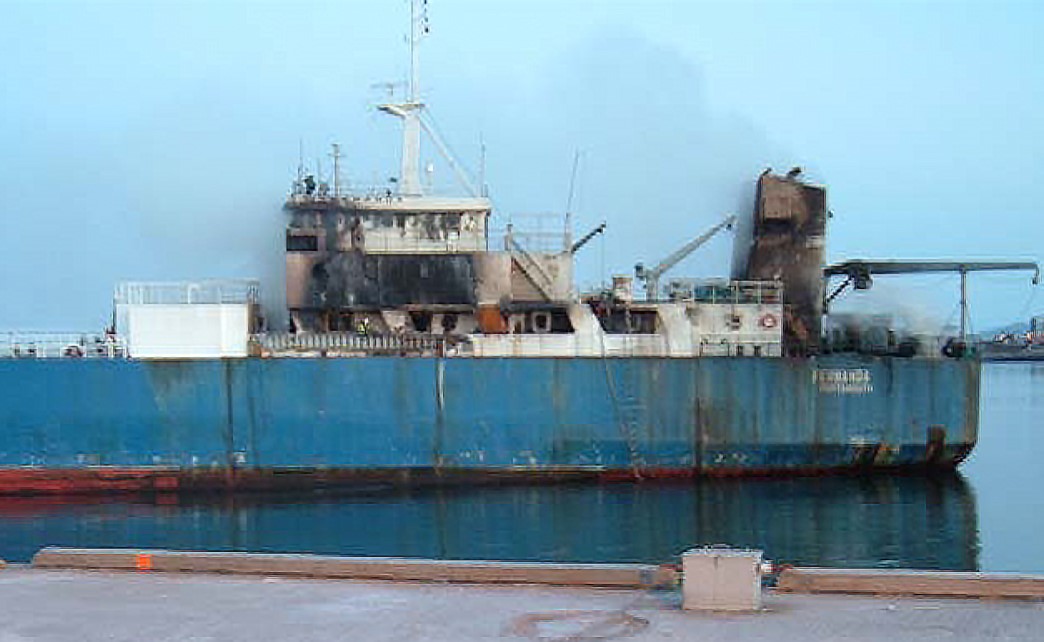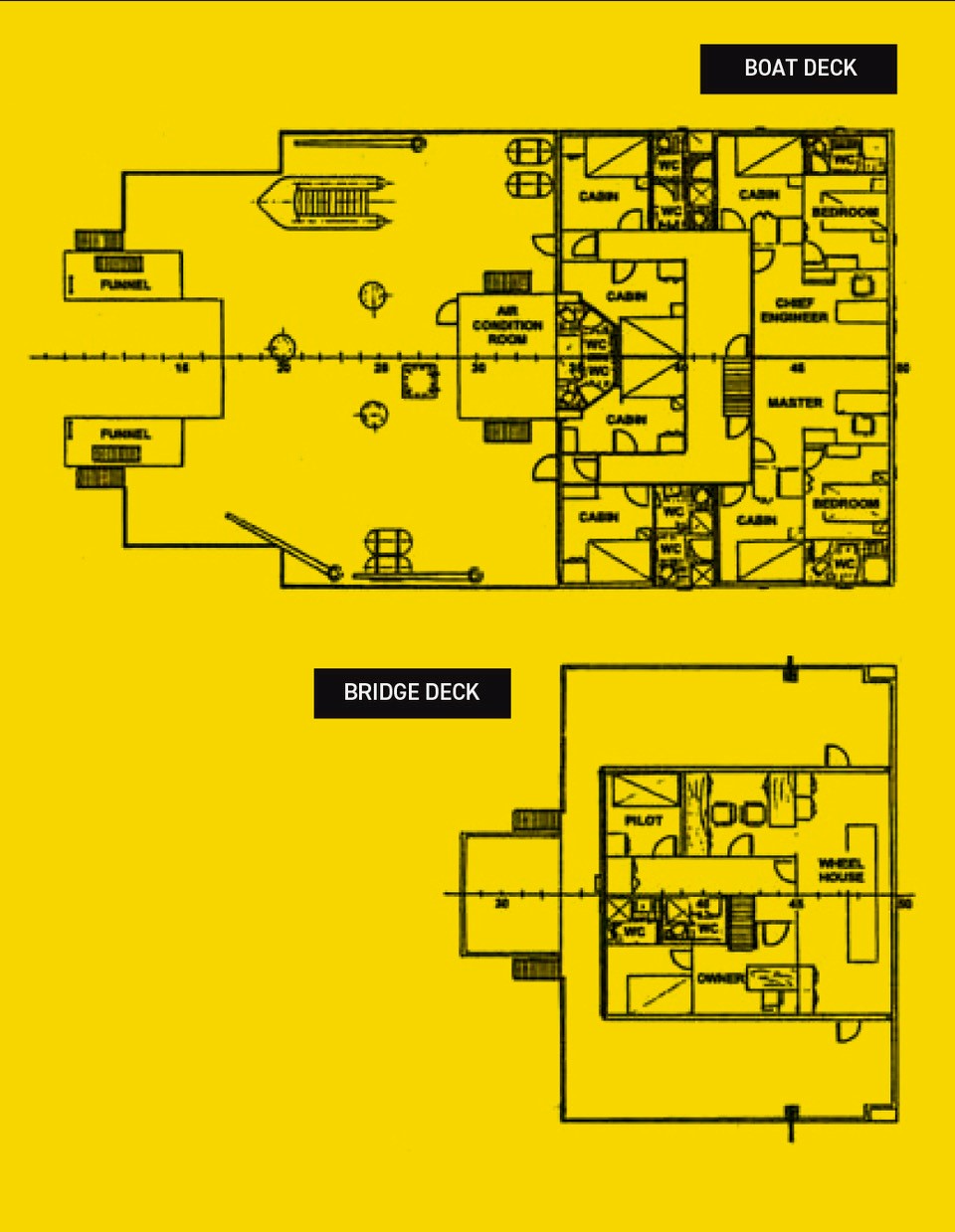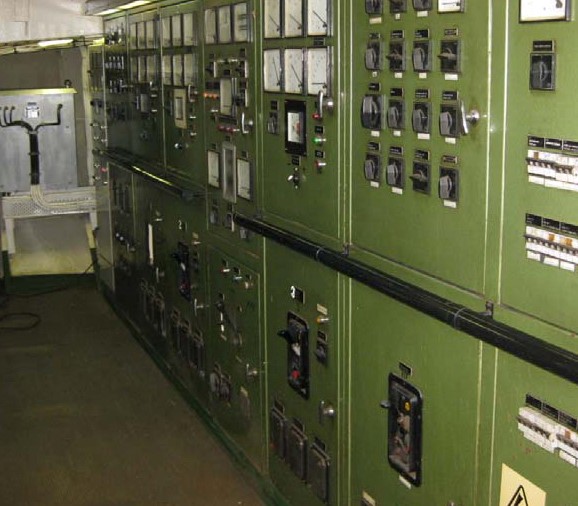FERNANDA a 2,576GT Ro-Ro ship built in 1982 (Figure 1) was nearing the end of her voyage when a fire broke out in the engine room. Despite an early decision to deploy the ship’s fixed halon firefighting system the fire could not be extinguished and the crew had to be evacuated by helicopter. No crew members were injured. However, the fire was not finally extinguished before 8 days later and the ship was eventually declared a constructive total loss (Figure 2).

Source: Commonwealth of Dominica Maritime Administration

Source: Commonwealth of Dominica Maritime Administration
WHAT HAPPENED?
At the time of the incident the Second Officer (2/O) was on watch on the bridge while the Second Engineer (2/E) and one rating were on watch in the engine room, as the vessel was not certified for unmanned engine room operation.
At the beginning of his watch, the 2/E recorded the machinery parameters in the log book indicating that everything was per normal operations. He then carried out a maintenance procedure on the lube oil purifier. The C/E who had been on watch from 0600 – 1200, came to the machinery space to check the operation of the purifier. He then instructed the 2/E to prepare some fuel injectors for the main engine. The C/E then retired to his cabin for some rest. The 2/E went to retrieve the fuel injectors at the engine room store which was located on the aft end of the upper deck close to the machinery space entrance. Meanwhile the rating on watch with the 2/E was working in the Electrician’s Store also located on the upper deck.

Source: Commonwealth of Dominica Maritime Administration
The Master was in his cabin when about 1250 UTC he heard the alarm from the fire detection panel and immediately went to the bridge (Figure 3). The machinery space and steering room fire detector was illuminated. He tried to reset the detector but could not do so. The Bosun was on the bridge so the Master instructed him to proceed to the engine room to assess the situation. The Bosun quickly returned and reported heavy smoke in the starboard side of the engine room. As the 2/E returned to the engine room he had met the Bosun who said the steering room was on fire. The 2/E had not heard the fire alarm and opened the door to the engine room and noted heavy smoke. At that moment the main engine stopped resulting in a power blackout and the emergency lighting came on. The 2/E then went to the door on the other side of the engine room and noted that the smoke was not as heavy but could not be entered without breathing apparatus. The Master made an announcement on the public address calling the crew to their fire stations.
The Bosun, together with a deck rating, donned breathing apparatus in order to enter the machinery space and assess the condition inside. They entered from the crew accommodation and immediately saw flames on the starboard side. They returned to the bridge and reported a large fire in the machinery space. The Master ordered the 2/O to sound the general alarm. The 2/E went on deck to assist with closing the fire dampers and machinery space ventilation openings and eventually returned to the bridge. The Master quickly made the decision to utilise the fixed halon fire-fighting system. Once the machinery spaces had been secured and all crew members accounted for he instructed the C/E and 2/E to release the halon.
At approximately 1310 UTC the Master contacted the ship’s managers as well as their agent in the next port to brief them on the situation. The agent contacted the local coastguard, who in turn contacted the ship to request information and broadcast a MAYDAY RELAY requesting all vessels in the vicinity to be stand by. No MAYDAY message was broadcasted by FERNANDA. It quickly became clear to the Master that while the halon initially appeared to contain the fire a serious situation was developing in the engine room. The Master advised the Coastguard about the rapid deteriorating situation and requested that the crew be evacuated. The crew donned their immersion suits and lifejackets, and the Master ordered them to launch two life rafts from the port side. At the time FERNANDA was 6 miles offshore and was rolling heavily in a heavy sea and swell. At 1320 UTC the Coastguard advised that a rescue helicopter was dispatched to the scene together with a local lifeboat and tug.
The Master donned an EEBD and went to his cabin to retrieve the crew’s official documents. On his return the bridge was smoke filled and he went first to the bridge wing and then to the open deck where the crew was mustered having launched the two life rafts and were awaiting the arrival of the rescue helicopter. The first helicopter arrived at 1436 UTC and the entire crew were evacuated by 1456 UTC and taken to the nearby Red Cross Station.
Following the incident an investigation conducted a of the machinery space and, as far as it could be determined, the fire started in the main switchboard (Figure 4).

Source: Commonwealth of Dominica Maritime Administration
Further details about the incident and the lessons learned are provided in the summary of the case study.
In addition, a presentation and reflective learning form have been prepared based on the incident as suggested training materials. These can be used by Members or their crew in any way they see fit to encourage reflection and gain the maximum learning from this incident: to consider why the incident happened; “what it means to me”, and to then relate the identified learning points to one’s own personal situation.
Finally, a Britannia commentary on the incident has been prepared which discusses the key points in more detail in order to help develop the reflective learning from the case study.
CASE STUDY MATERIAL
BSAFE INCIDENT CASE STUDY NO.10 – SUMMARY
BSAFE INCIDENT CASE STUDY NO.10 – REFLECTIVE LEARNING FORM
LESSONS LEARNED
The following lessons learned have been identified. These are based on the information available in the investigation report and are not intended to apportion blame on the individuals or company involved:
- Following the fire an investigation of the incident was conducted and it was established that the fire probably started in the main switchboard. From here it quickly spread upwards through open accesses to the funnels and later to the crew accommodation and navigating bridge as well as the upper tween deck cargo compartment.
- Two fire dampers were left open when the engine room was being closed down in preparation for the operation of the ship’s fixed HALON fire-fighting system. This is thought to have contributed to the development of the fire by allowing air to be drawn into the engine room. This also reduced the effectiveness of the HALON fixed fire-fighting system when it was operated.
- The location of the emergency fire pump in the steering gear room rendered it unusable due to the presence of heavy smoke in the access to the steering gear room. The access hatch was identified as being too small to enter the space wearing breathing apparatus.
- Housekeeping in the engine room may have contributed to the development of the fire based on the history of housekeeping issues recorded during past inspections as well as evidence observed during the investigation.
- The onboard Shipboard Emergency Situations Manual though containing clear measures for the prevention and detection of fires in the machinery spaces, it was advised that the managers should conduct a thorough review of the relevant portions of their Safety Management System specific to fire detection and prevention to ensure that they remain ship specific and adequate.
- The onboard annual drill schedule only prescribed a fire drill is to be conducted monthly without giving the Master any guidance with respect to nature of the drills to be conducted and the training elements to be achieved.
For more information on this incident email lossprevention@tindallriley.com.
THIS CASE STUDY IS DRAWN FROM THE INVESTIGATION REPORT PUBLISHED BY THE COMMONWEALTH OF DOMINICA MARITIME ADMINISTRATION.
THE PURPOSE OF THIS CASE STUDY IS TO SUPPORT AND ENCOURAGE REFLECTIVE LEARNING. THE DETAILS OF THE CASE STUDY MAY BE BASED ON, BUT NOT NECESSARILY IDENTICAL TO, FACTS RELATING TO AN ACTUAL INCIDENT. ANY LESSONS LEARNED OR COMMENTS ARE NOT INTENDED TO APPORTION BLAME ON THE INDIVIDUALS OR COMPANY INVOLVED. ANY SUGGESTED PRACTICES MAY NOT NECESSARILY BE THE ONLY WAY OF ADDRESSING THE LESSONS LEARNED AND SHOULD ALWAYS BE SUBJECT TO THE REQUIREMENTS OF ANY APPLICABLE INTERNATIONAL OR NATIONAL REGULATIONS, AS WELL AS A COMPANY’S OWN PROCEDURES AND POLICIES.

 English
English